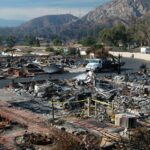Proving Liability in Environmental Class Actions
This article provides an in-depth exploration of the different forms of damages available in air pollution class action lawsuits. These cases often involve intricate legal processes and considerations, including the determination of appropriate compensation for the plaintiffs who have suffered due to negligence or intentional harm.

The focus of this examination will be the various types of damages awarded, such as:
- Medical expense recovery
- Compensation for property damage
- Pain and suffering claims
- Loss of earnings compensation
- Environmental restoration costs
- Legal fees and expenses
- Future expenses estimation
- Wrongful death compensation
The objective is to provide a comprehensive understanding of these damages, thus enabling legal practitioners, plaintiffs, and stakeholders to make informed decisions in air pollution class action lawsuits.
The article underscores the importance of these damages in restoring the victims' lives, safeguarding public health, and ensuring environmental justice.
Key Takeaways
- Class action lawsuits are important in fighting air pollution and allow large groups to pursue justice collectively.
- Damages in air pollution class actions can include compensation for medical expenses, property damage, pain and suffering, loss of earnings, environmental restoration costs, legal fees and expenses, future expenses estimation, wrongful death, and punitive damages.
- The calculation of damages in air pollution class actions can be complex and involve factors such as medical needs, long-term effects, ecological impact, and potential earnings.
- Pursuing legal avenues and obtaining damages in air pollution class actions is crucial for addressing environmental degradation, safeguarding public health, promoting environmental justice, and holding polluting entities accountable.
Understanding Class Action Lawsuits
Class action lawsuits, often utilized in cases of widespread harm such as air pollution, represent a collective legal mechanism whereby numerous plaintiffs who have suffered similar injuries or damages can seek redress in a unified manner. This type of legal proceeding, though complex, offers several advantages. Principally, it provides a means for large groups of individuals, who might otherwise lack the resources to litigate individually, to pursue justice collectively. Such lawsuits, however, are not without their unique challenges and procedural complexities.
The issue of lawsuit eligibility is one of the first hurdles to clear in a class action lawsuit. This requires establishing that the plaintiffs have suffered similar injuries from the same source, that there are enough plaintiffs to justify a class action, and that the representative plaintiffs will adequately protect the interests of the class. The procedural complexities involved in meeting these requirements can be substantial, necessitating expert legal guidance.
In the context of air pollution, these complexities are often amplified. Proving that a specific source of pollution has caused harm to a large group of individuals can be a daunting task, requiring extensive scientific evidence and expert testimony. Furthermore, the defendants in such cases—usually large corporations—often have extensive resources at their disposal for their defense.
Despite these challenges, class action lawsuits remain a vital tool in the fight against air pollution. They offer the potential for significant damages to be awarded, compensating the victims for their injuries and serving as a deterrent against future pollution. The importance of pursuing such legal avenues in the face of continued environmental degradation cannot be overstated.
Medical Expense Recovery
In the realm of environmental litigation, plaintiffs often seek compensation for medical expenses incurred due to health issues arising from contaminated air. The basis for these claims is typically the assertion that negligent or wrongful conduct by the defendant resulted in the release of harmful pollutants, subsequently leading to adverse health effects on the plaintiff or a group of plaintiffs. Consequently, the recovery of medical expenses becomes a pivotal element of such class action lawsuits.
Healthcare Cost Analysis plays a significant role in determining the extent of medical expenses recoverable in class action suits. Courts often demand a detailed breakdown of costs incurred in the diagnosis, treatment, and management of health conditions linked to air pollution exposure. This detailed analysis, typically prepared by medical experts, includes costs associated with hospital stays, medication, therapy, and any necessary medical equipment. Further, the analysis also takes into account future medical needs, which can significantly increase the total amount of damages sought.
Understanding treatment funding options is equally important in air pollution class actions. Often, plaintiffs are unable to bear the upfront costs of medical treatment, rendering them reliant on various funding options. These may include insurance claims, government assistance, or crowd-funding platforms. However, when these sources prove inadequate, the legal route often serves as an avenue to secure the necessary funding.
In the context of air pollution class actions, the ability to recover medical expenses serves as a crucial form of redress for the afflicted parties. Invariably, it underscores the importance of conducting in-depth healthcare cost analysis and exploring all possible treatment funding options to ensure comprehensive compensation.
Compensation for Property Damage
Addressing the implications of environmental degradation, compensation for property damage emerges as a significant component in the broader spectrum of environmental litigation. This form of compensation is particularly relevant in class action lawsuits involving air pollution, as the harmful effects often extend beyond personal health to include substantial damage to property.
In residential contexts, air pollution can lead to significant depreciation in property values. This Residential Depreciation arises from the diminished quality of life due to poor air quality, the potential health hazards, and the possible cost of remediation or restoration. For instance, homes exposed to high levels of pollutants may require extensive cleaning, renovations, or even replacement of certain materials to ensure safety and habitability, all of which can significantly lower the property's resale value. Therefore, plaintiffs in these cases can seek damages to compensate for this depreciation, ensuring they are not financially disadvantaged by the harmful actions of polluting entities.
The Agricultural Impact of air pollution is another important consideration in these lawsuits. Pollutants in the air can have disastrous effects on crops, livestock, and overall farm productivity. Prolonged exposure to pollutants can reduce crop yields, affect livestock health, and contaminate water sources, leading to substantial financial losses for farmers. Hence, damages in these cases can extend to cover the cost of lost income, increased operating costs, and the potential decrease in the value of agricultural land due to contamination.
Thus, compensation for property damage in air pollution class actions encompasses a broad range of potential damages, from residential depreciation to agricultural impact. This ensures a comprehensive approach to environmental justice, adequately addressing the multifaceted harm caused by air pollution.
Pain and Suffering Claims
Beyond the tangible impacts of environmental degradation, the intangible distress lodged in the form of pain and suffering claims surfaces as an indispensable facet of environmental litigation. This type of damage, often harder to quantify, speaks to the psychological harm inflicted on individuals who bear the brunt of air pollution. Such harm may manifest through emotional distress, trauma impact, and other effects on mental health, thereby necessitating a comprehensive approach to determining liability and compensation.
Emotional distress claims arise from the mental anguish experienced by individuals exposed to harmful pollutants. Studies have documented the correlation between poor air quality and the prevalence of anxiety disorders, depression, and other psychological conditions. Such impacts are particularly pronounced in communities disproportionately exposed to environmental hazards, underscoring the need for equitable legal remedies.
Trauma impact extends beyond the immediate physiological effects of pollution exposure. It also encompasses the long-term psychological stress associated with living in polluted environments. This may involve fear of developing chronic diseases, anxiety about property devaluation, or stress from displacement due to environmental degradation.
While quantifying these forms of suffering poses a challenge, ignoring them risks exacerbating the injustice of environmental harm. Courts have increasingly recognised the validity of these claims, reinforcing the integral role of pain and suffering damages in ensuring holistic redress for air pollution victims.
However, it must be stressed that these damages are not a panacea for the far-reaching impacts of air pollution. They should be seen as part of a broader strategy that includes proactive measures to curb emissions, remediate polluted environments, and promote environmental justice. This approach, while complex, promises a more equitable and comprehensive response to the pervasive issue of air pollution.
Loss of Earnings Compensation
Another critical facet of environmental litigation revolves around compensation for loss of earnings, which can arise when individuals' abilities to work are adversely affected by their exposure to hazardous environmental conditions. In particular, air pollution class actions often incorporate claims for loss of earnings, as the deleterious health impacts of air pollution can significantly impair an individual's ability to maintain consistent employment or perform at their full earning capacity.
The concept of earning capacity impact plays a crucial role in calculating this type of compensation. This involves assessing the potential earnings that a claimant would have been able to generate if not for the health implications suffered due to air pollution. In order to ascertain this, factors such as the claimant's age, skills, experience, and the nature of their occupation are taken into account. However, it also entails considering the overall economic climate, including job availability and the financial stability of the claimant's industry.
A comprehensive job displacement analysis is also integral to determining loss of earnings compensation in these cases. This systematic process evaluates the likelihood of a claimant being displaced from their job due to the health issues caused by air pollution, and the potential difficulties they may face when seeking new employment. This analysis takes into account the claimant's health status, their remaining functional capacity, and the job market's demand for their skills.
The evaluation of loss of earnings compensation in air pollution class actions, therefore, is a complex process that necessitates careful consideration of numerous factors. It requires meticulous attention to detail and relies on extensive evidence to ensure that claimants receive just recompense for the detrimental impact on their earning capacity. The ultimate goal is to provide financial relief that adequately reflects the severity of the claimant's predicament.
Punitive Damages
In the realm of environmental litigation, the imposition of punitive damages often serves a dual purpose: to penalize the offending party for egregious conduct and to deter similar behavior in the future. Punitive damages, unlike compensatory damages, are not intended to compensate the plaintiff for loss. Instead, they are designed as a form of punishment for the defendant's wrongful conduct and as a deterrent to prevent similar conduct in the future.
The assessment of punitive damages in air pollution class actions involves complex legal and scientific considerations. The application of damage assessment methods is critical in these cases, as it helps quantify the extent of the harm caused by the defendant's actions and informs the amount of punitive damages awarded. These methods may include the use of statistical models to estimate population exposure levels, health impact assessments to quantify potential health effects, or economic valuation techniques to assign monetary values to non-market damages such as loss of ecosystem services.
Moreover, punitive damages in air pollution class actions underscore the importance of corporate accountability in environmental stewardship. The threat of significant financial penalties provides a powerful incentive for corporations to adopt cleaner technologies, implement stricter emissions controls, and comply with environmental regulations. It also sends a clear message to the corporate sector that reckless disregard for the environment and public health will not be tolerated.
The application of punitive damages in air pollution class actions, therefore, serves not only as a punitive measure but also as a significant tool for promoting corporate responsibility and environmental sustainability. In this capacity, it plays an instrumental role in deterring future breaches and facilitating the broader objective of environmental protection.
Environmental Restoration Costs
Environmental restoration costs represent a significant financial burden for businesses found liable for environmental harm, and these costs are integral to achieving the goal of restoring the affected natural resources. In air pollution class action lawsuits, plaintiffs may seek to recover the expenses associated with the mitigation and restoration of the environment damaged by the defendant's actions. This type of damages is usually intended to make the environment whole again, returning it as closely as possible to its original state before the pollution occurred.
Restoration Techniques play an essential role in achieving this goal. These may include physical cleanup activities, such as removing pollutants from the air, water, and soil, as well as restorative actions like planting trees to replace those lost due to pollution. Moreover, these techniques often involve a combination of scientific research, engineering practices, and the application of ecological principles to restore and maintain the health and diversity of ecosystems.
The extent of Environmental Restoration Costs is often determined by assessing the Ecological Impact of the pollution. This involves evaluating the extent of harm caused to various aspects of the environment, including air, water, soil, flora, and fauna. The more significant the ecological impact, the higher the restoration costs are likely to be. This assessment provides a crucial measure of the scope of the restoration efforts required and, consequently, the overall price of restoration.
Thus, environmental restoration costs as a form of damages in air pollution class actions serve a dual purpose. They impose a financial penalty on the responsible party, thereby discouraging future pollution, and fund the necessary measures to restore the damaged environment, thereby helping to heal the ecological impact of the pollution.
Legal Fees and Expenses
Legal fees and expenses often constitute a substantial portion of the total financial implications in cases dealing with environmental harm. These costs arise from a broad spectrum of legal actions including, but not limited to, investigation, litigation, and settlement negotiation. Particularly in the realm of air pollution class actions, a significant number of complex issues demand extensive legal expertise, thereby escalating the magnitude of legal expenses incurred.
Attorney selection is a critical aspect that significantly influences the legal costs associated with air pollution class actions. The selection process involves identifying and retaining a law firm or attorney with extensive experience and a deep understanding of environmental law, class action lawsuits, and the multifaceted scientific aspects of air pollution. A proficient attorney or law firm is beneficial not just for the successful execution of the case, but can also effectively manage the legal expenses by streamlining the process, thereby mitigating the potential for unnecessary costs.
Fee negotiation is another crucial aspect that impacts the overall legal expenses. Parties involved in air pollution class actions must negotiate the attorney's fees, which are typically based on an hourly rate or a contingency fee arrangement. An effective negotiation process can lead to a mutually beneficial agreement, reducing the financial burden on the plaintiffs while ensuring adequate compensation for the attorneys.
These legal costs, while substantial, are a necessary aspect of air pollution class actions. They enable the effective legal representation of the plaintiffs, ensuring that the damages caused by air pollution are adequately addressed and the responsible parties are held accountable. The careful management of these expenses, through astute attorney selection and fee negotiation, can significantly influence the financial implications of such lawsuits.
Future Expenses Estimation
Estimating future expenses is a complex yet critical aspect of litigations related to harm caused by contaminants, requiring careful forecasting and meticulous planning. This task becomes even more challenging in air pollution class actions, where the potential for ongoing damage and long-term health effects necessitate a forward-looking perspective in damage calculation.
A comprehensive pollution impact analysis is instrumental in this process. This analysis provides vital insights into the scale and severity of the pollution, the affected population's size, and the likely duration of exposure. It also helps quantify the potential health effects, which can range from asthma and other respiratory diseases to more serious conditions like cancer, thereby establishing the basis for estimating future medical costs.
Remediation cost assessment is another critical component of future expense estimation. This involves calculating the cost of measures required to clean up the polluted area and prevent further harm. The assessment must consider a wide array of factors, including the pollution's extent, the remediation technologies available, their effectiveness, and potential regulatory changes that could impact future remediation costs.
In addition, future expenses estimation must also factor in the potential for ongoing disruptions to the livelihoods of the affected population. For instance, air pollution could reduce agricultural productivity, affecting the income of farming communities or lead to a decline in property values, thereby causing financial loss to homeowners.
The complexity and uncertainty underlying future expense estimation underscores the need for a robust, evidence-based approach that takes into account all potential future costs and impacts. This is vital not only for ensuring fair compensation to the victims but also for holding the polluters accountable for their actions.
Wrongful Death Compensation
Transitioning from the discussion on future expenses estimation, it is vital to delve into another profound area of damages available in air pollution class actions - wrongful death compensation. The palpable link between air pollution and premature deaths is well-documented in medical and legal literature, making this a significant aspect of air pollution litigation.
Wrongful death compensation is a legal remedy designed to provide financial reparation to the surviving family members of a deceased victim who succumbed to the adverse effects of air pollution. This form of compensation is multifaceted, encompassing not only the tangible economic losses but also intangible damages such as mental anguish.
Mental anguish compensation is a pivotal component of wrongful death claims. Survivors often experience emotional suffering characterized by grief, depression, anxiety, and loss of companionship following the untimely death of a loved one due to air pollution. The law recognizes such profound emotional distress, and thus, victims have the right to seek compensation for mental anguish. The quantification of this damage, however, is often a complex task as it requires a meticulous examination of the psychological impact on the survivors.
In addition to mental anguish compensation, survivors are also entitled to survivor benefits. These benefits are designed to offset the financial impact resulting from the loss of the deceased's income, support, and services. Survivor benefits may include loss of earnings, loss of potential future earnings, and expenses related to medical care or funeral costs.
The right to seek wrongful death compensation, including mental anguish compensation and survivor benefits, underscores the pursuit of justice in air pollution class actions. The law's provision for such compensation not only addresses the financial implications but also acknowledges the devastating emotional toll on survivors. Thus, these compensations are indispensable in restoring the loss and suffering of the aggrieved parties.
Frequently Asked Questions
What are the long-term impacts of air pollution on human health?
Long-term exposure to pollution sources poses significant threats to human health. Chronic respiratory diseases, cardiovascular disorders, and lung cancer are among the severe health implications observed.
Health monitoring studies reveal that air pollution also induces neurodevelopmental issues in children and accelerates cognitive decline in adults.
Furthermore, the World Health Organization attributes approximately seven million premature deaths annually to air pollution.
Therefore, mitigating air pollution is crucial for enhancing public health and reducing healthcare costs worldwide.
How does the government regulate air pollution to prevent future harm?
Government regulation of air pollution involves setting and enforcing emission standards to limit harmful pollutants released into the atmosphere.
This is achieved through stringent monitoring and imposing pollution penalties to deter non-compliance.
Regulatory bodies worldwide employ a range of strategies, from command-and-control approaches to market-based incentives, to ensure adherence.
These measures aim not only to mitigate current environmental harm, but also to preempt further damage, thereby safeguarding public health and the planet's future.
What measures can individuals take to protect themselves from air pollution?
To protect themselves from air pollution, individuals can take several measures:
- Monitor Indoor Air Quality: It is important to regularly check the air quality inside your home or workplace. This can be done using air quality monitors or by observing any signs of poor air quality such as excessive dust or odors.
- Ensure proper ventilation: Good ventilation helps to remove pollutants from indoor spaces. Open windows and doors to let fresh air in, especially when cooking or using cleaning products. Using exhaust fans in kitchens and bathrooms can also help to improve air circulation.
- Use air purifiers: Air purifiers with HEPA filters can help to remove harmful particles and pollutants from the air. Place them in commonly used areas such as bedrooms and living rooms for maximum effectiveness.
- Use Personal Protective Equipment: When exposed to high levels of pollutants, wearing personal protective equipment such as N95 masks can provide a physical barrier against harmful particles. This is particularly important for individuals with respiratory conditions or those who work in industries with high levels of pollution.
- Reduce dependence on fossil fuels: Fossil fuels are a major source of air pollution. By reducing our reliance on them, we can help to decrease pollution levels. This can be done by using public transportation, carpooling, biking, or walking instead of driving, and supporting renewable energy sources.
- Promote greener alternatives: Encouraging the use of cleaner energy sources such as solar or wind power can help to reduce air pollution. Supporting initiatives that promote sustainable practices, such as recycling and reducing waste, can also contribute to a cleaner environment.
By implementing these measures, individuals can significantly reduce their exposure to air pollution and protect their health.
How does air pollution contribute to climate change?
Air pollution significantly contributes to climate change through the release of pollutants from various pollution sources. These pollutants, especially greenhouse gases like carbon dioxide and methane, trap heat in the atmosphere, leading to global warming.
Additionally, particulate matter can affect cloud formation and precipitation patterns, further altering the climate.
Therefore, emission reduction strategies, such as limiting the use of fossil fuels and promoting renewable energy, are imperative to mitigate the impact of air pollution on climate change.
Are there any global initiatives to combat air pollution and its effects?
Indeed, numerous global cooperation strategies exist to combat air pollution and its effects. These include international pollution laws, such as the Paris Agreement and the Kyoto Protocol.
Additionally, the World Health Organization promotes guidelines to improve air quality, while the United Nations Environment Programme engages in significant efforts to reduce pollutants.
These initiatives reflect a concerted global effort, demonstrating the recognition of air pollution as a pressing environmental issue requiring immediate and collaborative action.
Conclusion
In conclusion, the types of damages available in air pollution class actions are multifaceted, encompassing:
- Medical expenses
- Property damage
- Emotional distress
- Lost earnings
- Environmental restoration
- Legal costs
- Future expenses
- Wrongful death compensation
The comprehensive nature of these compensations demonstrates the severity of air pollution's impacts.
Therefore, the pursuit of these class actions is crucial in:
- Holding polluters accountable
- Ensuring environmental preservation
- Securing justice for victims.

This post has been generated by AI and was not reviewed by editors. This is Not legal advice. Please consult with an attorney.




